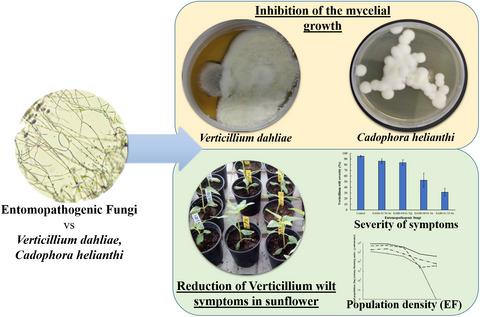当前位置:
X-MOL 学术
›
Plant Pathol.
›
论文详情
Our official English website, www.x-mol.net, welcomes your feedback! (Note: you will need to create a separate account there.)
Evidence of soil‐located competition as the cause of the reduction of sunflower Verticillium wilt by entomopathogenic fungi
Plant Pathology ( IF 2.7 ) Pub Date : 2020-06-24 , DOI: 10.1111/ppa.13230 Pedro Miranda‐Fuentes 1, 2 , Ana Belén García‐Carneros 1 , Ana María Montilla‐Carmona 1 , Leire Molinero‐Ruiz 1
Plant Pathology ( IF 2.7 ) Pub Date : 2020-06-24 , DOI: 10.1111/ppa.13230 Pedro Miranda‐Fuentes 1, 2 , Ana Belén García‐Carneros 1 , Ana María Montilla‐Carmona 1 , Leire Molinero‐Ruiz 1
Affiliation

|
The increasing limitation of agrochemicals for disease control is a major challenge for European agriculture and a spur to developing environmentally friendly approaches such as biological control. Entomopathogenic fungi, which have been used in the control of insect pests for a long time, also have other uses, such as being antagonists of fungi, including plant pathogens. We determined the in vitro effect of three strains of Metarhizium brunneum and two of Beauveria bassiana against Verticillium dahliae and Cadophora helianthi, causal agents of sunflower wilts. Both M. brunneum and B. bassiana were able to inhibit the mycelial growth of the sunflower pathogens and, according to the dual culture and microscopy results, two types of antagonism were observed as being dependent on the strain: competition and/or antibiosis. Greenhouse experiments showed that, after soil treatments with entomopathogens and plant inoculation by root immersion in conidial suspensions of V. dahliae, the entomopathogens were able to efficiently persist in the soil, and three of the four strains even significantly reduced the severity of symptoms in sunflowers. Interestingly, molecular analysis showed that all the strains were able to establish themselves as endophytes in sunflowers in the absence of V. dahliae. When the plants were inoculated with V. dahliae, we detected the pathogen, but not the entomopathogen, in the sunflowers by molecular methods. The results of this work suggest that the protection conferred by M. brunneum and B. bassiana against verticillium wilt might not be plant‐located, but is probably the consequence of their competition with V. dahliae in the soil.
中文翻译:

土壤定位竞争是昆虫病原真菌减少向日葵黄萎病的原因的证据
用于疾病控制的农用化学品日益受到限制,这是欧洲农业面临的主要挑战,也是开发生物防治等环境友好方法的动力。昆虫病原真菌长期用于防治害虫,还有其他用途,例如作为真菌的拮抗剂,包括植物病原体。我们确定了三株绿僵菌和两株白僵菌对大丽轮枝菌和向日葵(向日葵枯萎病的病原体)的体外作用。M. brunneum 和 B. bassiana 都能够抑制向日葵病原体的菌丝生长,根据双重培养和显微镜结果,观察到两种类型的拮抗作用取决于菌株:竞争和/或抗菌。温室试验表明,在用昆虫病原体处理土壤并通过将根浸入大丽花孢子悬浮液中进行植物接种后,昆虫病原体能够有效地在土壤中持续存在,四种菌株中的三种甚至显着降低了向日葵症状的严重程度. 有趣的是,分子分析表明,在没有大丽花弧菌的情况下,所有菌株都能够在向日葵中建立内生菌。当植物接种大丽花弧菌时,我们通过分子方法在向日葵中检测到病原体,但未检测到昆虫病原体。这项工作的结果表明 M. brunneum 和 B. bassiana 对黄萎病的保护可能不是植物定位的,但可能是它们在土壤中与大丽花竞争的结果。在用昆虫病原体处理土壤并通过将根浸入大丽花孢子悬浮液中进行植物接种后,昆虫病原体能够有效地在土壤中持续存在,四种菌株中的三种甚至显着降低了向日葵症状的严重程度。有趣的是,分子分析表明,在没有大丽花弧菌的情况下,所有菌株都能够在向日葵中建立内生菌。当植物接种大丽花弧菌时,我们通过分子方法在向日葵中检测到病原体,但未检测到昆虫病原体。这项工作的结果表明 M. brunneum 和 B. bassiana 对黄萎病的保护可能不是植物定位的,但可能是它们在土壤中与大丽花竞争的结果。在用昆虫病原体处理土壤并通过将根浸入大丽花孢子悬浮液中进行植物接种后,昆虫病原体能够有效地在土壤中持续存在,四种菌株中的三种甚至显着降低了向日葵症状的严重程度。有趣的是,分子分析表明,在没有大丽花弧菌的情况下,所有菌株都能够在向日葵中建立内生菌。当植物接种大丽花弧菌时,我们通过分子方法在向日葵中检测到病原体,但未检测到昆虫病原体。这项工作的结果表明 M. brunneum 和 B. bassiana 对黄萎病的保护可能不是植物定位的,但可能是它们在土壤中与大丽花竞争的结果。
更新日期:2020-06-24
中文翻译:

土壤定位竞争是昆虫病原真菌减少向日葵黄萎病的原因的证据
用于疾病控制的农用化学品日益受到限制,这是欧洲农业面临的主要挑战,也是开发生物防治等环境友好方法的动力。昆虫病原真菌长期用于防治害虫,还有其他用途,例如作为真菌的拮抗剂,包括植物病原体。我们确定了三株绿僵菌和两株白僵菌对大丽轮枝菌和向日葵(向日葵枯萎病的病原体)的体外作用。M. brunneum 和 B. bassiana 都能够抑制向日葵病原体的菌丝生长,根据双重培养和显微镜结果,观察到两种类型的拮抗作用取决于菌株:竞争和/或抗菌。温室试验表明,在用昆虫病原体处理土壤并通过将根浸入大丽花孢子悬浮液中进行植物接种后,昆虫病原体能够有效地在土壤中持续存在,四种菌株中的三种甚至显着降低了向日葵症状的严重程度. 有趣的是,分子分析表明,在没有大丽花弧菌的情况下,所有菌株都能够在向日葵中建立内生菌。当植物接种大丽花弧菌时,我们通过分子方法在向日葵中检测到病原体,但未检测到昆虫病原体。这项工作的结果表明 M. brunneum 和 B. bassiana 对黄萎病的保护可能不是植物定位的,但可能是它们在土壤中与大丽花竞争的结果。在用昆虫病原体处理土壤并通过将根浸入大丽花孢子悬浮液中进行植物接种后,昆虫病原体能够有效地在土壤中持续存在,四种菌株中的三种甚至显着降低了向日葵症状的严重程度。有趣的是,分子分析表明,在没有大丽花弧菌的情况下,所有菌株都能够在向日葵中建立内生菌。当植物接种大丽花弧菌时,我们通过分子方法在向日葵中检测到病原体,但未检测到昆虫病原体。这项工作的结果表明 M. brunneum 和 B. bassiana 对黄萎病的保护可能不是植物定位的,但可能是它们在土壤中与大丽花竞争的结果。在用昆虫病原体处理土壤并通过将根浸入大丽花孢子悬浮液中进行植物接种后,昆虫病原体能够有效地在土壤中持续存在,四种菌株中的三种甚至显着降低了向日葵症状的严重程度。有趣的是,分子分析表明,在没有大丽花弧菌的情况下,所有菌株都能够在向日葵中建立内生菌。当植物接种大丽花弧菌时,我们通过分子方法在向日葵中检测到病原体,但未检测到昆虫病原体。这项工作的结果表明 M. brunneum 和 B. bassiana 对黄萎病的保护可能不是植物定位的,但可能是它们在土壤中与大丽花竞争的结果。


























 京公网安备 11010802027423号
京公网安备 11010802027423号